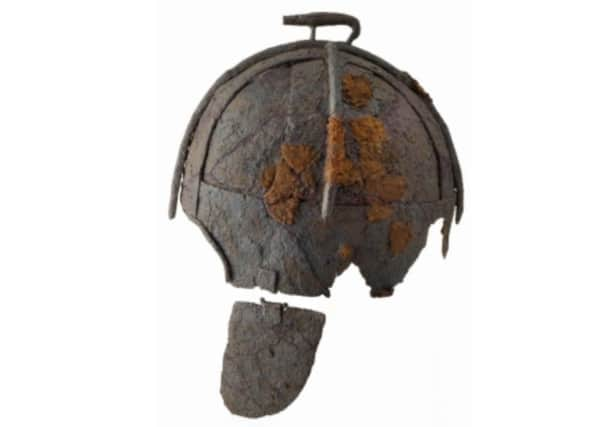Warrior treasures exhibition to feature very rare burial goods from Northamptonshire


The items within the Wollaston Warrior group are Anglo-Saxon burial goods from the grave of an elite warrior probably from the late seventh century. The contents of the grave included an exceptionally rare helmet and a sword – both denoting the high status of their owner.
The Wollaston Warrior’s grave was first discovered by archaeologists in 1997 in a gravel pit operated by Pioneer Aggregates just outside the town of Wollaston in the east of Northamptonshire. Alongside the scarce remains of the warrior, a young man probably in his twenties at the time his death, this seventh century Anglo-Saxon grave contained a helmet, a sword, knife, three iron buckles, a dress hook, and a copper alloy hanging bowl, with one surviving decorative mount.
Advertisement
Hide AdAdvertisement
Hide AdThe ‘Pioneer’ helmet was only the fourth Anglo Saxon helmet to be recovered in England at the time of its discovery. The helmet is adorned with a simple boar crest at the top and would once have had two cheek plates, of which only one remains. Given their rarity the burial remains are of great historical and archaeological significance.
Claudia Rogers, PhD placement student at the Royal Armouries in Leeds who has been undertaking research on the Wollaston grave goods in preparation for the exhibition said: “The burial goods indicate that the grave belonged to a male of high status.
“The hanging bowl was made from one sheet of bronze, requiring the talents of a highly skilled craftsman. The bowl would have originally been suspended from three hooks and decorated with escutcheons. This bowl certainly reflects the standing of the Wollaston Warrior, although it remains unclear what uses the bowl had.”
The rest of the Warrior Treasures exhibition focuses on fittings from weapons found within the Staffordshire Hoard collection. It tells the story of their discovery, providing a fascinating glimpse into the warrior culture of a period in Anglo-Saxon history. These fittings were stripped from swords and seaxes (single-edged knives), and are thought to represent the equipment of defeated armies from unknown battles during the first half of the seventh century. The fittings are intricately decorated with gold, silver and semiprecious gems, and represent the finest quality Anglo-Saxon craftsmanship.
Advertisement
Hide AdAdvertisement
Hide AdNorthamptonshire-based artist and blacksmith Stuart Makin has been awarded a commission by the Royal Armouries museum in Leeds to create a sculptural response to the spectacular items which will be on display in the exhibition. The commission has been supported using public funding by the National Lottery through Arts Council England.
The Wollaston Warrior Group is in the care of the Royal Armouries museum in Leeds from private lenders. The Staffordshire Hoard treasure is owned by Birmingham City Council and Stoke-on-Trent City Council and cared for on their behalf by Birmingham Museums Trust and The Potteries Museum & Art Gallery. It is currently undergoing one of the UK’s largest archaeological research projects, conducted by Barbican Research Associates on behalf of the owners and Historic England, who fund the project.
Entry to the exhibition is free and will be accompanied by an events programme. Further details can be found at the Royal Armouries website at http://warrior-treasures.uk